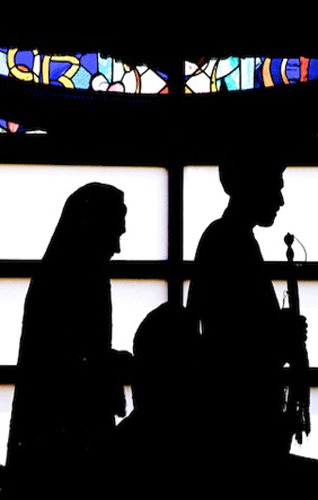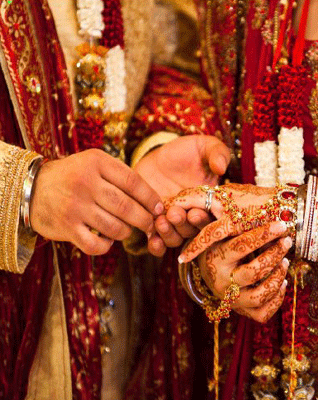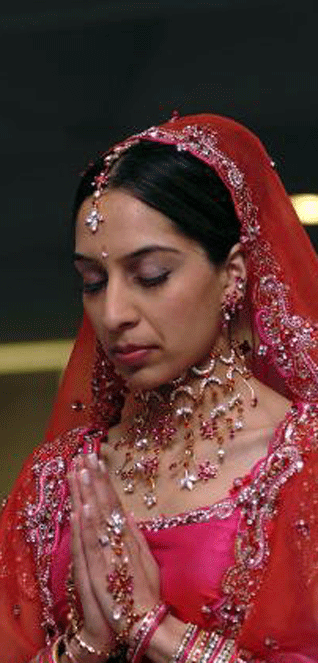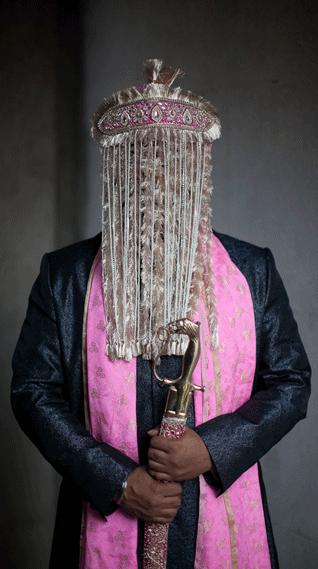Resource Library
Marriage in Sikhism: Part I - Background
by MANJIT SINGH
EDITOR'S NOTE: The author of the following article has presented the Sikh teachings on marriage.
We all know that the reality is different, however. Most Sikhs have not been following these teachings since the fall of the Sikh kingdom and the annexation of Punjab by the British. During the Guru period, Sikhs were commited to upholding the teachings. During the time of the Misls and Ranjit Singh's rule, the status of Sikh women continued to be as equals per the teachings. Many Europeans who passed through Punjab during that period attested to the fact that the Sikh community was the only community on the subcontinent that treated its women as equals.
After the fall of Sikh Raj, the Sikh community went into a slump and became a target for Hindu influence. Since the middle of the 19th century, Hindu practices and social norms have been creeping at an accelerated rate. We all know that we are not keeping up with the real Sikh teachings but then most are not concerned about personal failings.
This article will allow the reader to self-reflect where one stands vis-a-vis one's commitment to follow the path shown to us by our Gurus.
Today: Part I - Background
Tomorrow: Part II - THe Sikh Marriage
PART I - BACKGROUND
Sikh approach to marriage, family and the status of women in society has been documented very clearly in the Guru Granth Sahib. These three topics are interrelated and fall under the cluster of social and survival values in Sikhism.
In order to gain a proper prospective on marriage in Sikhism, it is not possible to discuss any of these three topics without touching upon the other two. It is also necessary to go back in history in order to understand why Sikhism came to adopt a different approach in this area of human development which ended up being very avant-garde in comparison with the corresponding approaches of other religions that were in practice in the Indian subcontinent five hundred years ago.
* * * * *
Sikhism originated in the Province of Punjab in the northwest region of the subcontinent towards the end of the 15th century. At the time of Sikhism's birth, the cultural and religious landscape of this area was a mélange of Hindu, Buddhist, Jain and Islamic religious influences.
While Hinduism, Buddhism and Jainism are indigenous to the subcontinent, the fourth, Islam, came from the Arab lands to the northwest in the 8th century in the area called the Province of Sind in modern day Pakistan. Sind is an adjacent province on the southwestern edge of Punjab. Christianity and Judaism had also been present in the subcontinent for a very long time but their respective influences did not reach the northwest to any appreciable degree until modern times.
Islam remained localized in Sind for almost two hundred years as a peaceful and neighborly way of life under the sufis. As a result of the spread of Islam in central and west Asia, invasions of Punjab by the Turk-Afghan forces started to happen from 1000 A.D. These invasions, which were bloody, ruthless and were launched at different intervals by various Turk-Afghan chiefs become a regular feature of subcontinental life for the next two hundred years. The main aim of these invaders was to spread Islam and to plunder the wealth of India, including forcible removal of women for slavery. There used to be public auctions of captured women in the bazaars of Ghazni and Kabul following each invasion.
As a consequence of the forgoing events, the Islamic influence became the dominant political factor in Punjab penetrating local society at the expense of traditional religions. By late 12th century, Punjab and Sind became part of the Afghan kingdom.
Propagation of Islam by force became an instrument of state policy in the conquered territories.
The next major upheaval occurred in 1206 A.D. when the local Afghan governor of Punjab declared autonomy from the Turk-Afghan kingdom upon the death of its king. He proclaimed himself king and became an independent ruler. This was the beginning of dynastic Muslim rule in India which lasted well into the early 19th century. Of course, there were many wars between Turk-Afghan and Hindu princes during this period but we do not need to go into these details.
The Indian subcontinent is the home of a very ancient civilization. The coming of Islam as a ruling authority in the 13th century created a major cultural clash between the new political masters who, as conquerors, considered the Islamic way of life superior to the native system of social, religious and cultural values. The natives became particularly exercised when the new masters started to interfere forcibly with the old and established ways of native life including forced religious conversions.
The condition of the Indian society, in a comparative sense, at that time was identical to the clash of values and cultures that took place between the natives of North and South America and the Europeans who, as conquerors, came to exercise complete political control on both these continents, thus marginalizing the indigenous populations.
The net impact of the above change created a dramatic worsening of the position of Indian women in society. As it is, pre-Islamic Indian society considered women inferior to men. Women were treated as mere property whose only value was as household servants and/or to be used for the entertainment of men. Her function was only to perpetuate the race. Yogis considered women as seducers, temptresses and distractions from man's spiritual path.
Widows were denied the right to remarry. Widows were expected to burn themselves on their husband's funeral pyre. Female infanticide became common either to escape the burden of dowry or to be saved the indignity of seeing their young daughters being captured for sale in the bazaars of Kabul and Ghazni. Women could not inherit property under normal circumstances. The coming of the Turk-Afghan rule also brought a plethora of new restrictions for the local women.
For example, the practice of purdah or veil, polygamy and the lack of equal rights for women per the Sharia laws came with the new rulers. This had a profound and a compounding impact in further lowering the overall status of women of the subcontinent.
Drive for Modernization
Guru Nanak, the founder of Sikhism, started his ministry in the last decade of the 15th century. He outlined a multi-pronged approach for the spiritual renewal of his people. He quickly came to the realization that regardless of religious affiliations, a society where fifty percent of the population - namely, the women - do not merit basic respect and equal treatment in their daily lives was doomed for ever. Guru Nanak found this discrimination towards one half of the population simply unacceptable.
He very boldly and in a matter of fact way started to talk about letting women enjoy the same rights as men in all - spiritual, social and cultural - aspects of every day life. He rejected the man made notion of inferiority of women and their subjugation by men. He considered the nuclear family, i.e. the father, mother and children, as the basis of a civilized society. He stated that a woman was the pivot of the unit called family. Without her there was no family. He wrote hymns to uphold the gender equality principle.
Women attending Sikh prayer meetings now sat as equals with men. This took place five hundred years ago - in a society that was and still is, characterized by severe degradation of women. These bold steps by Guru Nanak were nothing short of a revolution. This is the only example of its kind where a religious leader took such an open stand to advance the cause of women
His successor Gurus continued with the reform process. Sikh Gurus informed their followers that branding women as unequal to men went against the teachings of Sikhism.
By the early 17th century, Sikh disciples had successfully demonstrated that meaningful social change was possible. The third Sikh Guru, Guru Amar Das, went to the extent of appointing women as head of four dioceses out of twenty-two such establishments. Of the 146 missionaries that he appointed, he named 52 women to these positions. These developments in favor of women were phenomenal by any standards. The net outcome was that followers of Sikhism started to lead society towards renewal and modernization.
After centuries of exploitation and injustice in the name of different religions, women of the Indian subcontinent who belonged to the Sikh tradition began to experience full equality with men. Sikh teachings made it very clear that man and woman are two sides of the same coin. God created humanity which consists of two genders.
According to Sikh tenets, man and woman are the two wheels of the chariot of life: both have an equal role in making the chariot run smoothly.
Guru Nanak preached that it is the deeds or behavior of a person that determined the net worth of an individual and not his/her gender. Guru Nanak stated in unequivocal terms that women are equal to men and have an equal share in all rights and privileges of a civil society. Sikh women have, as a result, enjoyed rights similar to men through the centuries. This is how Guru Nanak spoke about women in one of his hymns on page 473 of the Guru Granth Sahib:
Of women are we born, of women conceived,
To woman betrothed and wedded;
Women we befriend, by her continues the human race;
When woman dies, woman is sought, for it is she who maintains world order.
Why revile her of whom are born the great?
Of woman is born another woman; none exists without her;
The Eternal God, says Nanak, is the only One not born of her
Nine of the ten Sikh Gurus were married. The Guru period in Sikh history runs from 1469-1708 A.D. It was the Eighth Guru who did not marry as he died before he could reach marriageable age. The wives of the nine Gurus played very important spiritual, domestic and public roles in their capacity as wives, mothers and grandmothers, respectively, in the affairs of the community during their life time.
There are numerous stories of how these women became an inspiration to the fledgling community as role models for every one to follow.
[S. Manjit Singh teaches Sikhism in the Faculty of Religious Studies at McGill University, Montreal, Quebec, Canada. He is Director of McGill's Chaplaincy Services. Presently, he is the President of the Interfaith Council of Montreal.]
Continued tomorrow: Part II - The Sikh Marriage
August 21, 2010
Conversation about this article
1: N. Singh (Canada), August 21, 2010, 5:24 PM.
S. Manjit Singh ji: Thank you, this was an excellent account. However, since you are a scholar, here is my feedback. Personally, I felt that your article was more biased in reiterating the Islamic influence with regards to the (mis)treatment of Indian women, and merely skirted over the issue that within Hinduism - e.g., in the Bhagvadgita, women are considered subservient to men. In fact, Mannu (one of the founders of Hinduism) puts Sudras, women and animals in the same category. I feel it is important to make that emphasis because historically Sikhs have been told that the Mughuls were responsible for much 'cruelty', especially against women. However, I would like to emphasize that the mistreatment of women in India pre- and post-dates the arrival of Islam and is mostly Hindu in origin.






